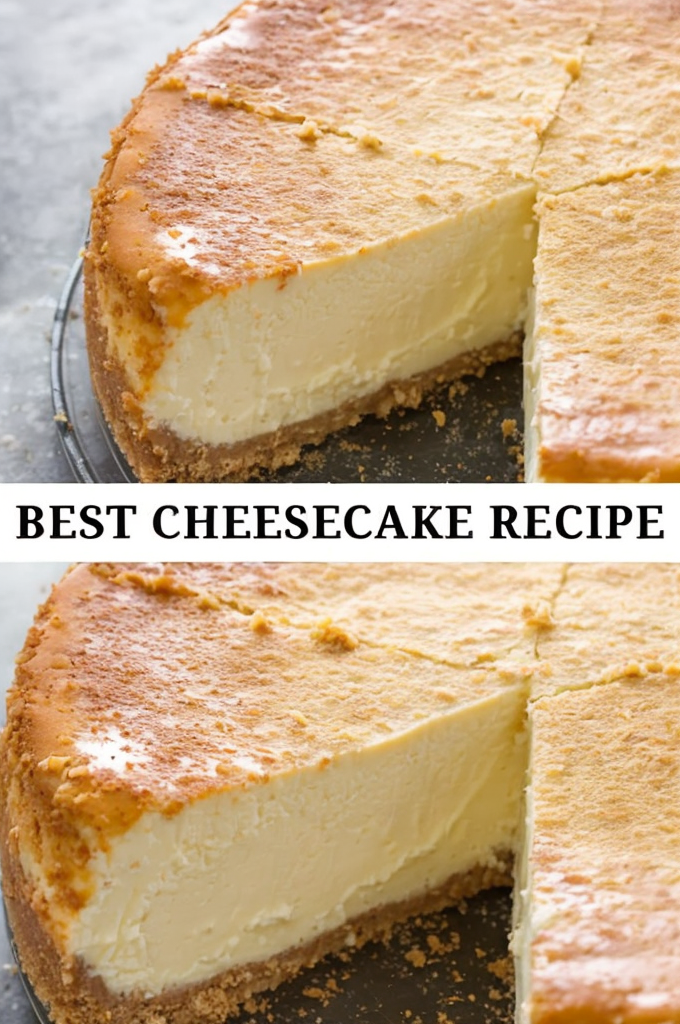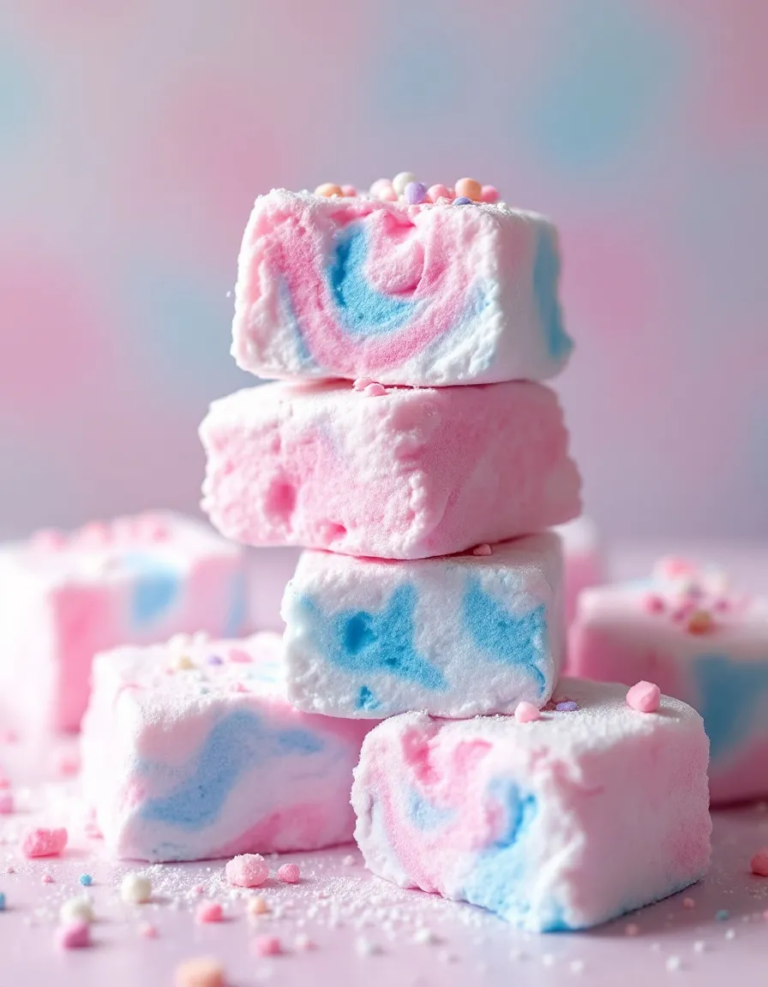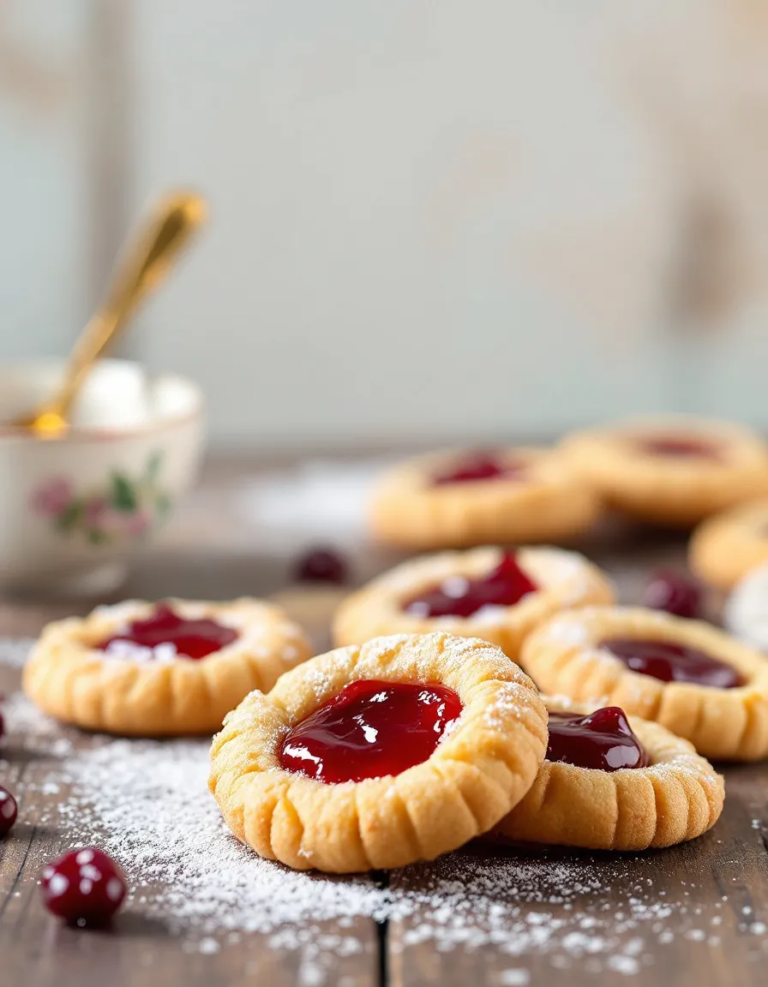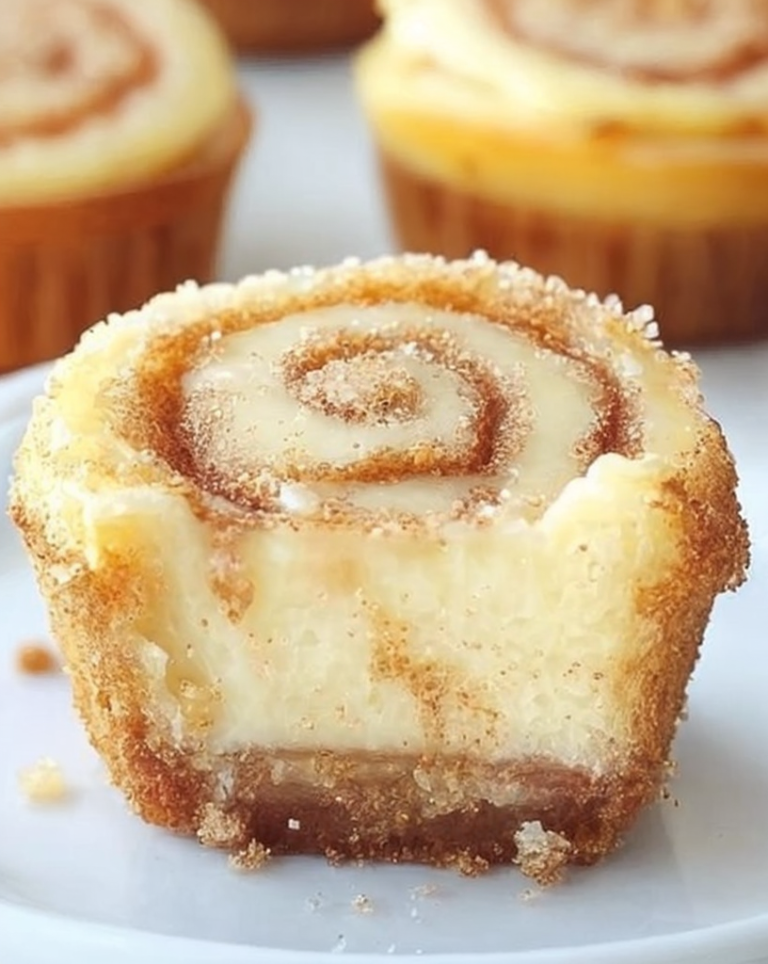Ultimate Cheesecake Recipe – No-Bake Family Favorite
Ultimate Cheesecake Recipe: A No-Bake Family Favorite
Indulge in the ultimate no-bake cheesecake recipe, a family favorite that delightfully merges creamy texture with rich flavors. This recipe ensures a luxurious, smooth cheesecake with the perfect balance of sweetness and tang. Ideal for any occasion, this no-bake treat saves time in the kitchen while delivering a dessert sure to impress. With a nutty, buttery crust and a luscious filling, it’s a sensory experience with every bite. The visual delight of this cheesecake makes it a brilliant centerpiece for gatherings, satisfying both the palate and the eyes.
Quick Recipe Highlights
- Flavor Profile: Creamy vanilla with a hint of tang from cream cheese balanced by a subtle sweetness.
- Texture: Velvety smooth filling atop a crunchy, buttery crust.
- Aroma: Rich vanilla and sweet cream notes with a hint of citrus zest.
- Visual Appeal: Perfectly set cheesecake with a glossy finish and optional colorful toppings.
- Skill Level Needed: Ideal for novice bakers with easy achievable steps.
- Special Equipment: Springform pan for easy release, and a mixing bowl for smooth blending.
Recipe Overview
- Difficulty Level: This recipe is deemed easy due to the absence of any baking process. It requires simple mixing techniques that do not necessitate precision baking.
- Category: This cheesecake falls into the dessert category, perfect to complement any meal.
- Cuisine: Primarily an American classic with European influences reflected in its creamy texture and rich flavors.
- Cost: Economical ingredients make this cheesecake accessible for frequent indulgence.
- Season: Best enjoyed year-round; the no-bake element is particularly favored during warmer months.
- Occasion: Perfect for birthdays, family gatherings, and special holidays when a quick yet indulgent dessert is needed.
Why You’ll Love This Recipe
Taste the rich, smooth filling of this cheesecake, where every bite melts in your mouth leaving subtle notes of vanilla. The interplay between the creamy cheesecake and the crunchy, buttery graham cracker crust provides a sublime texture contrast that satisfies cravings for both creamy and crunchy delights.
This no-bake cheesecake recipe is the epitome of convenience, requiring minimal preparation effort with no need for baking, allowing for maximum enjoyment with minimal work. It’s the ideal choice for busy home cooks wanting a delicious dessert option without spending hours in the kitchen.
Nutritionally, this cheesecake provides a balance of protein and fats, offering a moderately healthy indulgence. By adjusting sugar and opting for low-fat cream cheese, it can align with many dietary goals without sacrificing flavor.
Serving this cheesecake elevates any gathering, making you a hit among family and friends. It offers a sense of nostalgia reminiscent of family holidays, enticing guests with its classic charm and unforgettable taste.
Cost-effectiveness is another draw of this recipe. Using pantry staples, it transforms simple ingredients into a decedent masterpiece without breaking the bank, proving that sophisticated desserts can indeed be budget-friendly.
Historical Background and Cultural Significance
The cheesecake we know today has roots tracing back to ancient Greece, where historians believe the earliest recorded mention was by the physician Aegimus, who wrote a book on the art of making cheesecakes. Over centuries, its recipe evolved across regions, gaining prominence in Europe during the Renaissance.
In America, the cheesecake became an emblematic dessert during the 18th century, as it adapted to various local ingredients. Introduced by European immigrants, it became a staple in American culinary tradition, notably evolving in New York where its distinct rich and creamy version gained fame.
Across different cultures, cheesecakes assume diverse forms, varying from the Japanese cotton-soft cheesecake to Italy’s ricotta-laden variations. These regional adaptation nuances showcase the cheesecake’s versatile appeal and cultural integration.
The no-bake version specifically resonates with modern lifestyles, reflecting the fast-paced need for convenience without sacrificing flavor or tradition. It merges time-honored techniques with contemporary tastes, maintaining its status as a beloved family favorite across generations.
Ingredient Deep Dive
Cream cheese is the cornerstone of this cheesecake, originally introduced in 1872 by American dairyman William Lawrence. He unintentionally improved upon the European soft cheese Neufchâtel, creating a dense, rich variant that became synonymous with the iconic New York cheesecake.
Nutritionally, cream cheese provides protein and calcium, essential for bone health. Selecting high-quality cream cheese ensures a superior texture, while opting for reduced-fat versions offers a lighter alternative for calorie-conscious bakers. Proper storage includes refrigeration to maintain its freshness and creamy consistency.
Graham crackers lay the foundation of the crust, with origins dating back to the 19th century as part of the Graham diet reform. They offer a subtly sweet, nutty flavor that perfectly contrasts the creamy filling while being rich in fiber.
To retain optimal freshness, store graham crackers in airtight containers, but if unavailable, finely crushed digestive biscuits make for an excellent substitution. Their hearty texture and slightly malty taste provide a perfect foil to the creamy cheesecake layers.
Common Mistakes to Avoid
- Overmixing the filling can lead to an unsuitably dense texture. Fold ingredients gently to ensure a light, fluffy cake.
- Using low-quality cream cheese can result in a lackluster flavor. Choose a full-fat or high-quality brand for best results.
- Skipping the chilling step can prevent proper setting, turning the cheesecake into a runny mess.
- Failing to properly measure ingredients can throw off consistency balance, especially for the crust-to-filling ratio.
- Rushing through the crust-making step leads to a base that might crumble when serving. Press firmly into the pan for stability.
- Forgetting to line your springform pan may cause the cheesecake to stick, making it difficult to remove.
- Underchilling: The cheesecake needs adequate refrigeration time to fully set.
- Using overly cold ingredients makes it difficult to achieve the smooth, homogenous mixture necessary for a seamless filling.
- Mismanaging substitutions: Always verify substitution ratios (like gelatin for agar-agar in gelatin-free variations) to ensure consistency.
- Inappropriate toppings application may weigh down the cheesecake, so add them just before serving for them to maintain their visual appeal.
Essential Techniques
Mastering the art of evenly pressing the crust into your pan is crucial. This foundation supports the entire cheesecake, ensuring it holds together when sliced and served. Use the bottom of a glass to press down firmly and evenly, creating a flat and compact crust.
Achieving the perfect filling consistency starts with properly softened cream cheese. Letting it sit at room temperature softens it for easy blending. A smooth filling is key, so incorporate each ingredient patiently to avoid lumps.
Pro Tips for Perfect Ultimate Cheesecake
Temper your cheese: Ensure all dairy ingredients are at room temperature for a seamless blend. This will guarantee the filling is ultra-smooth and lump-free.
Chill thoroughly: Allow the cheesecake to chill for at least 4 hours or overnight to ensure proper setting, enhancing both texture and flavor.
Balance your flavors: Incorporate a hint of lemon zest or juice to provide a fresh contrast to the richness of the cheese and sugar.
Watch your crust: Pre-press your crust to gauge the consistency. If it’s too crumbly, add a touch of melted butter to bind it more solidly.
Test your set: Reference the cheesecake’s firmness by lightly pressing the center—a gentle bounce-back signifies it’s fully set for slicing.
Layer textures: Add coated berries or a dollop of whipped cream as garnishes just before serving to enhance visual appeal without weighing down the cake.
Adapt to seasons: Incorporate seasonal fruits like berries or citrus fruits for a fresh, dynamic twist on this classic dessert.
Variations and Adaptations
Regional adaptations allow enjoyment of this cheesecake with different cultural twists. For a Mediterranean version, incorporate Greek yogurt for added tang and creaminess, or swap the graham crust for crushed almonds or walnuts for that rustic, nutty flavor.
For a seasonal variation, consider adding pumpkin puree and spices during fall or a fresh berries compote sauce for a summer delight. These adjustments augment the basic recipe without complicating the cooking process, keeping the recipe accessible and resonant throughout the year.
Dietary modifications are simple and effective. For a gluten-free version, use gluten-free graham crackers for the crust, and replace sugar with honey or a sugar substitute for a more natural sweetness that compliments the cheesecake beautifully.
For those who prefer a different layered texture, swirl in fruit preserves or chocolate ganache into the cheesecake which adds depth to its flavor profile and extraordinary visual allure, making the dessert uniquely yours.
Serving and Presentation Guide
Plating this no-bake cheesecake can be an art in itself. Use a sharp knife to ensure clean slices, and wipe it clean with warm water between each cut to maintain the presentation’s precision.
Garnish each piece with fresh, vibrant fruits or mint leaves for a splash of color, bringing a festive, eye-catching appeal. Sprinkle a dusting of powdered sugar or cocoa for added elegance, spotlighting an inviting contrast between creamy white cheesecake and decorative elements.
Traditional accompaniments often include a side of berries or warm fruit compote, while modern interpretations might suggest a light chocolate drizzle or a scatter of nuts for textural variety.
Serving temperature should be chilled straight from the fridge to maintain the cheesecake’s firm integrity, especially during summer servings where the setting is more vulnerable. Consider adding small dessert forks to encourage measured and appreciative bites.
Wine and Beverage Pairing
Complement this cheesecake with a crisp, light white wine such as a sweet Riesling or a Moscato. These wines offer floral and fruity notes that highlight the dessert’s creamy composition without overwhelming its delicate taste.
For non-alcoholic alternatives, try serving with iced herbal tea infused with citrus or berries, offering a refreshing counterpoint to the cheesecake’s richness.
If you’re a coffee enthusiast, a smooth Americano or a light roast coffee can provide a pleasant bitterness that offsets the sweetness of the cheesecake, perfect for concluding a satisfying meal with friends or family.
Temperature considerations for beverages, akin to cheesecake, should remain chilled or lightly cooled. These choices not only complement the dish but enhance its enjoyment, providing a coherent dining experience from start to end.
Storage and Shelf Life
Proper storage ensures your cheesecake remains fresh and palatable. Cover the cheesecake with plastic wrap or store it in an airtight container to prevent it from drying out or absorbing other odors from the fridge.
The ideal refrigerated temperature is maintained between 35-38°F, preserving both taste and consistency. When exposed to these conditions, the cheesecake can last for up to five days without sacrificing quality.
If opting for freezing, wrap the individual slices in plastic wrap before placing them in a freezer-safe bag to prevent freezer burn. You can safely freeze the cheesecake for up to two months; however, note that freezing may slightly alter the texture, turning it more crumbly upon thawing.
Watch for changes in smell or mold development, a sign that the product is no longer safe for consumption. Reheat from frozen by moving to the refrigerator overnight, avoiding microwave thawing, which could lead to warm sections and unresolved pockets.
Make Ahead Strategies
Plan by prepping the cheesecake a day in advance, giving adequate time to set and develop a richer flavor. This advance preparation makes serving day stress-free and more enjoyable.
Divide steps strategically, like preparing the crust beforehand and refrigerating it until you’re ready to make the filling. This streamlined process keeps everything organized, reducing last-minute frenzy.
Maintain quality by keeping elements separate—only integrate any toppings or fruits at the last minute to ensure they remain fresh, crisp, and visually appealing.
Reheating isn’t required since this is a chilled dessert, but if frozen, the fridge is the best place for a careful thaw ensuring an even and gentle return to the right temperature.
Scaling Instructions
Scaling the cheesecake to suit different occasions is straightforward. To halve the recipe, reduce ingredients proportionally, paying special attention to crust ratios to maintain the balance between base and filling.
For doubling or tripling, adjust your springform pan size accordingly and increase the chilling time slightly to accommodate the larger volume.
Consider using additional or larger mixing bowls when scaling up to avoid spillage. This ensures even mixing and prevents batter breakdown, guaranteeing a consistency that is both appealing and palatable.
Larger batches may require extended chilling to ensure full setting, which is essential for structural integrity when slicing and serving.
Nutritional Deep Dive
The ultimate no-bake cheesecake is more than just a delightful dessert; it provides balanced macro-nutrients ideal for indulgence without guilt. It offers moderately beneficial protein levels derived from both dairy and nuts, and fats providing satiety.
Micronutrients include calcium from cream cheese for bone health and possible added vitamins from fresh toppings or nuts.
Portion analysis hints at the need for moderation, as this dessert is calorie-dense due to its creamy base. However, it can be easily portion-controlled to fit dietary goals, offering the satisfaction of sweetness without overindulgence.
Weight management tips involve pairing smaller cheesecake servings with a side of high-fiber fruits, curbing larger cravings while offering additional nutritional content.
Dietary Adaptations
For gluten-free adaptations, using gluten-free graham crackers or oats as a substitute crust proves satisfying and seamless. They offer a familiar crunchy bite while adhering to dietary restrictions without sacrificing taste.
Making the recipe dairy-free requires a few swaps, such as using cashew or almond cream cheese and coconut cream for an equally creamy consistency that aligns with non-dairy preferences.
Going vegan involves substituting traditional honey with agave syrup and adapting the filling to incorporate vegan-friendly cheese or tofu. These alterations maintain the dessert’s essence while respecting plant-based principles.
Low-carb adjustments are achievable by using almond flour for crust and natural sweeteners like stevia or erythritol to cut down carbohydrates, making it a cozy fit for keto-friendly diets.
The Recipe
Ultimate No-Bake Cheesecake
Serves: 8
Prep Time: 20 mins
Cook Time: 0 mins
Total Time: 20 mins
Kitchen Equipment Needed
- 9-inch springform pan
- Mixing bowls
- Electric mixer
- Spatula
- Measuring cups and spoons
Ingredients
- 1 1/2 cups graham cracker crumbs
- 1/4 cup melted butter
- 2 tablespoons sugar
- 2 cups cream cheese, softened
- 1 cup sugar
- 1 teaspoon vanilla extract
- 2 cups heavy cream, whipped
Directions
- In a mixing bowl, combine graham cracker crumbs, melted butter, and sugar until well mixed. Press into the bottom of a 9-inch springform pan. Refrigerate for 10 minutes to set.
- In another bowl, beat softened cream cheese and sugar until smooth and creamy. Add vanilla extract and continue beating until fully blended.
- Gently fold in whipped cream to the cream cheese mixture, ensuring not to overmix to maintain a light texture.
- Pour the cream cheese mixture over the crust, spreading evenly with a spatula. Smooth the top with the back of a spoon.
- Refrigerate for at least 4 hours or overnight until set.
- Release from the pan, slice, and serve chilled with desired toppings.
Recipe Notes
- Consider adding zest of lemon or lime for an added citrus burst.
- Top with fresh fruits or fruit compote for extra flavor and color.
- Substitute heavy cream with coconut cream for a tropical variation.
Troubleshooting Guide
If your cheesecake isn’t setting properly, make sure it is refrigerated for the full recommended time and placed evenly throughout the fridge to promote consistent temperature control.
For flavor balance, ensure proper measurement of vanilla and sugar to maintain a harmonious blend. Adjusting quantities according to taste can also remedy any imbalance issues you encounter.
Temperature difficulties arise from ingredients not at room temperature; plan ahead to remove dairy products an hour before preparation.
Equipment challenges may stem from an overcrowded mixing space. Use ample room to maneuver and move through each step comfortably, preventing accidental oversights or ingredient slip-ups.
Ingredient substitutions, such as swapping for low-calorie sweeteners, may require additional work to maintain taste and texture, so research equivalents thoroughly before attempting.
Timing concerns, especially related to chilling, can be circumvented by preparing a day ahead, ensuring adequate set time for a superior result.
Recipe Success Stories
Our readers continuously share positive experiences with this recipe, often enjoying great success by adding personalized twists such as layering fruit jams or incorporating candied nuts, demonstrating the cheesecake’s versatility and adaptability.
Community feedback often highlights the simplicity and taste, making it a cherished staple at family gatherings, praised for its ease and for evoking fond traditions.
Variations such as adding a chocolate ganache layer or creating mini personal servings using individual ramekins have been noted as impressive adaptations favored for special occasions.
Readers appreciate tips such as opting for quality tools and taking time to prepare ahead, emphasizing that these small adjustments enhance the outcome significantly.
Photography tips from users reinforce capturing the elegance of each slice, encouraging experimentation with angles and lighting to best showcase the cheesecake’s appeal.
Frequently Asked Questions
Can I use low-fat cream cheese?
Yes, low-fat cream cheese can be used as a healthier alternative, however expect a softer filling resulting in a less creamy texture.
How do I prevent the crust from becoming soggy?
Ensure the crust is firmly pressed into the pan and that it’s adequately set in the fridge. This firm foundation helps prevent moisture absorption.
Can I freeze the cheesecake?
Yes, it is suitable for freezing when wrapped thoroughly, with best results achieved by slicing before freezing to aid easier serving later on.
What are some alternative crust options?
Aside from graham crackers, options include crushed vanilla wafers, digestive biscuits, or even crushed nuts blended with a bit of sugar and butter for binding.
How do I make the filling firmer?
Incorporating slightly less whipped cream or incorporating gelatin provides additional firmness, making the filling denser and more cheesecake-like.
What is the best method for slicing?
Use a sharp knife heated under warm water, then dried, and make clean cuts for each slice, wiping the blade between each slice for perfect presentation.
Can I add flavors to the filling?
Absolutely! Consider extracts such as almond or peppermint, or fresh zest from lemons or limes. It’s an easy way to infuse new flavors.
What size of springform pan should I use?
A 9-inch springform pan is recommended for even distribution. Scale portions according to variations in pan size if adjusting.
Is it necessary to line the pan with parchment paper?
Parchment helps in removing the cheesecake cleanly, especially if planning to serve without bottom tray support. It avoids sticking and eases side release.
What toppings are recommended?
Berries, fruit sauces, caramel drizzles, or chocolate shavings all top this cheesecake beautifully. Adjust to suit themes or seasons while ensuring nothing overwhelms the base.
How far ahead can I make this cheesecake?
Make this cheesecake up to two days before serving. It’s safe and tasty as flavors meld together beautifully the longer it sets.
Can this recipe be made sugar-free?
Yes, substitute sugar with natural or artificial sweeteners like erythritol or stevia, adjusting quantities based on sweetness levels, ensuring smooth blending into the mix.
Additional Resources
Explore the world of desserts with our comprehensive selection of related recipes, including baked cheesecakes, tart variations, and sandwich cookies. These recipes expand upon the textures and flavors found in our cheesecake, introducing innovative techniques.
Our technique guides delve deeper into processes such as whipping cream and blending mixtures for smooth results, invaluable for novices and experts alike seeking to refine skills.
Seasonal variation guides suggest how to incorporate fresh seasonal ingredients into your recipes, ensuring year-round enjoyment with a nod to local produce and flavor harmonies.
Discover insightful equipment recommendations from basic kitchen tools to specialized bakeware, aiding the achievement of professional results from the comfort of your home.
Join the Conversation
We invite you to share your meal on social media using our hashtag, expanding the community engaged in this sweet journey. Those who enjoy expressing creativity will find this cheesecake ripe for photographic exploration, capturing the elegance of its layered beauty.
Submit your reviews, comments, and variations; we encourage creative permutations of the recipe shared by fellow enthusiasts proud of their personalized renditions.
Join our active community, participating in forums and discussions to discover additional tips and stories or track emerging trends in no-bake culinary creations.







